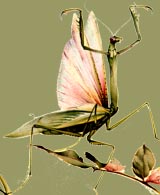 |
 back back 
Insects and Biodiversity
Insects and People
Insect Characteristics
|
|




INSECT CHARACTERISTICS
PHYSIOLOGY
Frozen flies
Insects are ectotherms. Their body temperature is dependent on heat from the environment and closely follows temperatures to which they are exposed. Insects are able to survive adverse climatic conditions partly because of their "cold-bloodedness". Many insects can withstand periods of freezing temperatures.
Insect Anti-freeze
In Canada, insects have adapted in different ways to northern conditions that are most clearly observed in the arctic. In northern areas the metabolic rates of many species are high compared to insects from more temperate conditions. To survive extremely cold winters, insects have two main types of adaptations. Their body fluids may contain a type of anti-freeze substance or "ice crystal nucleators." The anti-freeze substances are called cryoprotectants and allow for supercooling or freezing resistance. Cryoprotectants inhibit ice formation in cells. Ice crystals in cells can be lethal because as the ice crystals enlarge they rupture and destroy cells. Some arctic insects supercool down to -60 °C. Supercooling points of -40 °C have also been observed outside the arctic.
Insects "On Ice"
Other insects handle the cold in a different way. They are able to resist freezing because their extracellular fluids manufacture nucleators, a substance that accelerates the process of crystal formation. The extracellular fluid freezes more readily than the intracellular fluid. As the extracellular fluid freezes it draws water out of the cells thus lowering their freezing point. Ice crystals that form outside the cells do little damage.
 Back to top
Back to top

|